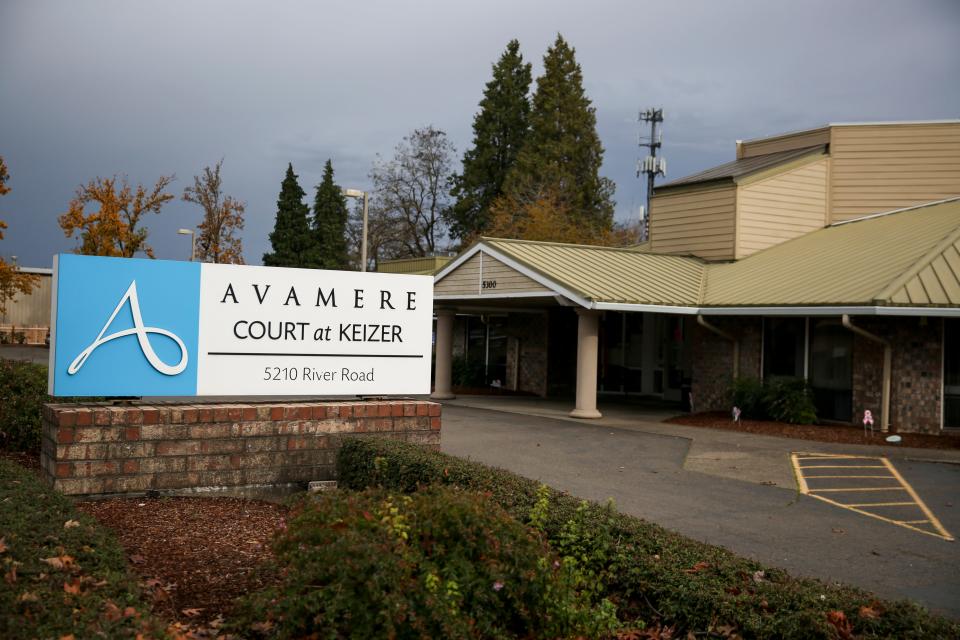How we reported this investigation into long-term care and COVID-19 in Oregon

- Oops!Something went wrong.Please try again later.
The impact of COVID-19 in Oregon facilities that primarily care for older adults was high-profile in the early days of the pandemic. It had started fading from the headlines a year later, in March 2021, when auditors from the Oregon Secretary of State looked at the state's handling of COVID-19 in these care settings.
The report, which found about half of the Oregonians who had died from COVID-19 lived in a long-term care setting, piqued the interest of state government accountability reporter Claire Withycombe.
Auditors found that while the state did take some proactive measures, it could do more to reduce infections in care. They suggested the state penalize facilities that didn't comply with infection control protocols. The Department of Human Services insisted they had levied about $500,000 in fines.
Withycombe was interested in when and why the state did take action and wanted to look closer at those fines.
READ THE SERIES: A third of COVID-19 deaths in Oregon tied to care facilities, which faced few penalties
She requested state data about penalties levied against facilities for COVID-19 issues, dug through entries on the state's licensing website and reviewed thousands of pages of documents from state and federal agencies.
There are several types of long-term care facilities providing care in Oregon and varying levels of oversight. While some information is available in real-time about which facilities have COVID-19, very little is readily available to the public about how it has spread and been handled in these facilities — places where our parents, grandparents and loved ones reasonably should expect to be safe.

For months, nonessential visitors, including volunteers from a state office dedicated to oversight of facilities — couldn't enter them. So what was happening on the ground?
Each week, the state's health department publishes information about the number of cases and deaths in group care settings, including eldercare.
Withycombe looked at Oregon Health Authority data to select about 40 facilities that had large outbreaks, repeated outbreaks and high death totals, She also requested reports from the Department of Human Services about state visits to those facilities to better understand what they, and the state, had done to try to prevent the spread of COVID-19.
When the records started to arrive in late June, information about case counts was redacted — meaning whole swaths of information about the spread of COVID-19 were blocked.
Withycombe also researched publicly available records from the federal government, which regulates some types of care homes, about infection control measures in those facilities.
Withycombe began threading together the weekly reports of COVID-19 cases in long-term care facilities with the dates of the state reports she received and the federal reports she looked up through the Centers for Medicare and Medicaid Services.
The Statesman Journal requested updated data on state fines on Jan. 7. DHS provided a spreadsheet Jan. 21 showing 18 civil penalties related to COVID.
Of those, though, the Statesman Journal was only able to identify three that were issued for how the facility managed the spread of COVID-19: a $12,870 fine to Gracelen Terrace, a $1,500 fine to Tanner Spring Memory Care and a $1,013 fine to Harvest Homes Inc.
As of mid-January, nearly 2,000 Oregonians have died of COVID-19 in connection with a group care facility. That number includes residents, workers and close contacts of staff and workers. It also includes adult foster homes, which Withycombe did not include in her reporting.
The health department repeatedly refused to provide the Statesman Journal with the total number of residents who have died in group care. The agency's weekly report on group care outbreaks, however, has the number of workers — as of Jan. 12, three — who have died in connection with a group care facility.

Withycombe sought out sources who lived in care facilities or who had loved ones who did, to better understand the human impact of the pandemic and of the state's approach. She requested and received from the Secretary of State's Office documents reflecting the research and interviews auditors had conducted for their March 2021 report.
The Statesman Journal found a regulatory system that emphasized supporting facilities rather than punishing them for lapses in health measures meant to protect residents against COVID-19.
"Maybe more people would have died if they didn't do what they did," Fred Steele, the state’s Long Term Care ombudsman, said of the state's approach, "But we still had a lot of cases and a lot of death in long-term care from COVID because we weren't stronger, and we should have been, in our regulatory approach."
Infections continue to be an issue in care homes as the COVID-19 pandemic lurches into its third year.
On Jan. 12, the American Health Care Association, which represents about 14,000 nursing homes and assisted living facilities, issued a report warning that U.S. nursing homes are experiencing an "alarming" spike in cases due to the omicron variant of COVID-19.
You may contact Claire Withycombe at cwithycombe@statesmanjournal.com, 503-910-3821 or follow her on Twitter @kcwithycombe.
Support local journalism by subscribing to the Statesman Journal.
This article originally appeared on Salem Statesman Journal: How we reported this series on long-term care and COVID-19 in Oregon

